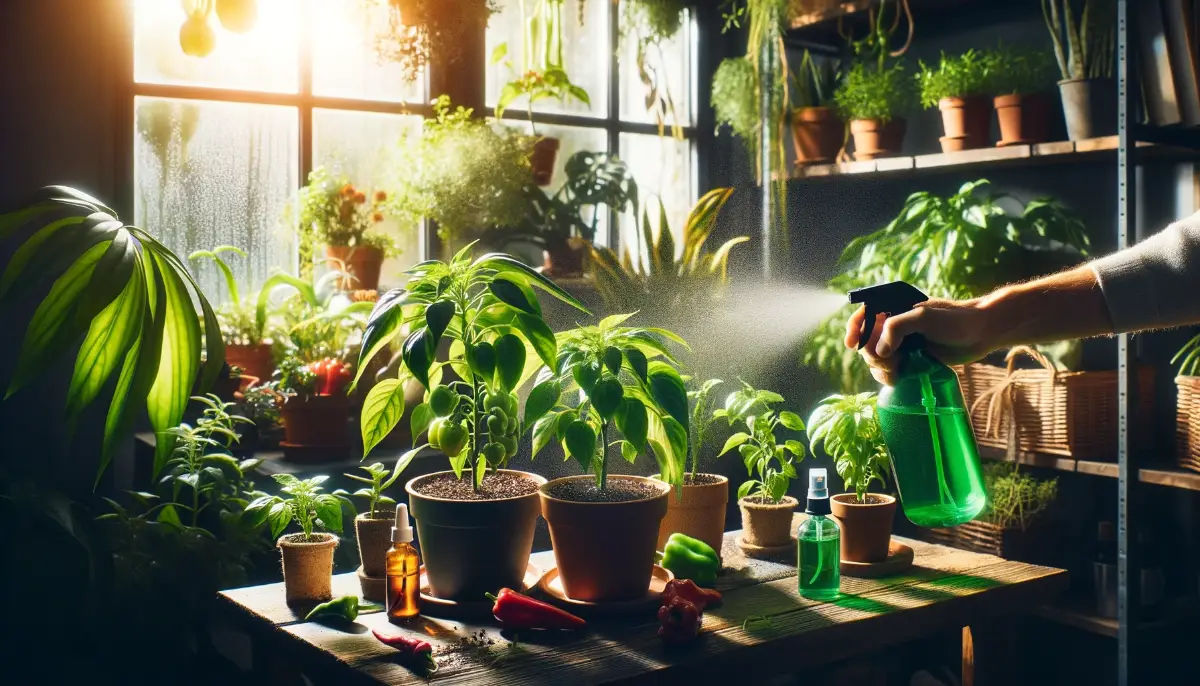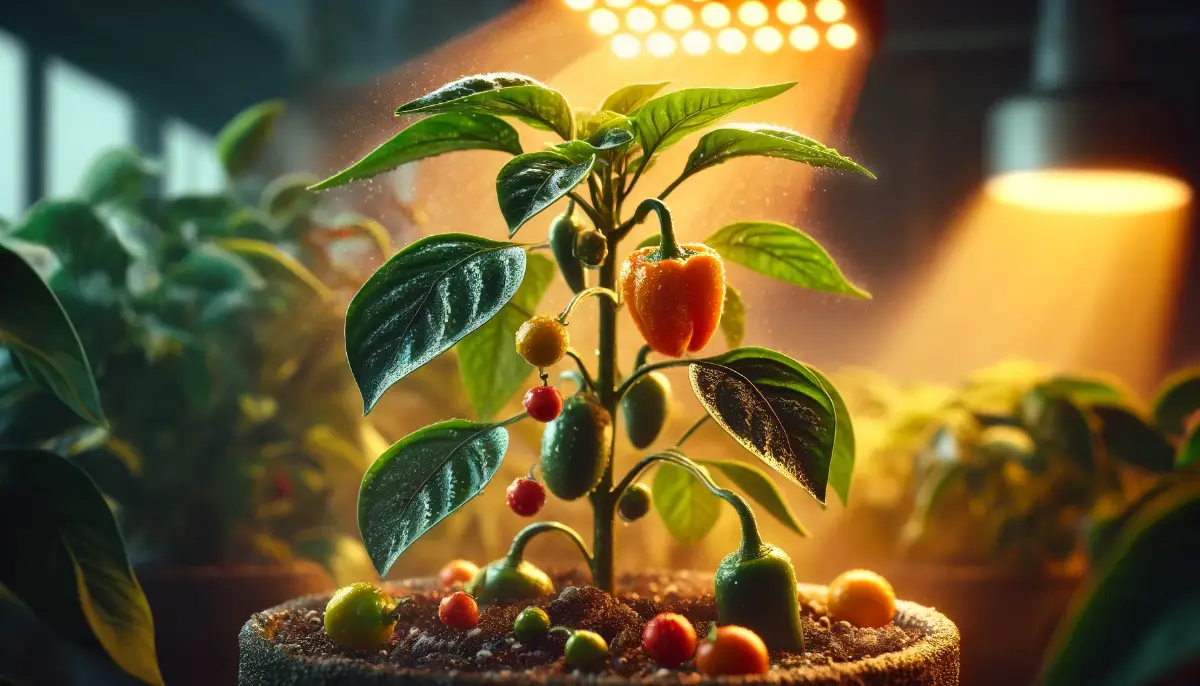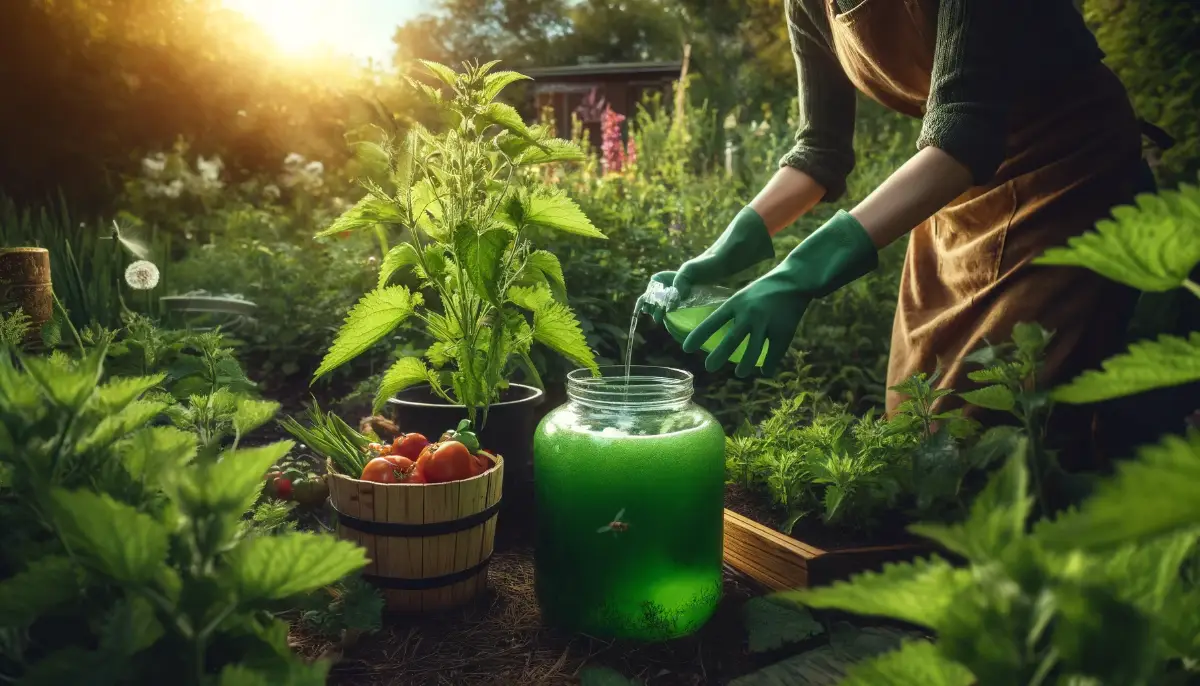Hot peppers, especially cayenne peppers, are effective in deterring pests in the garden.
Capsaicin, the active compound in hot peppers, acts as a natural repellent for various insects and animals, including spider mites, cabbage worms, and even larger pests like rodents and deer.
Capsaicin: The Heart of Pepper’s Power
At the heart of hot peppers’ pest deterrent capabilities lies capsaicin, a compound as renowned for its culinary heat as for its repellent properties. Registered as a biochemical pesticide since 1962, capsaicin works by imparting an undesirable level of spiciness to treated plants, making them less appealing to a variety of pests, from insects to mammals.
Its effectiveness is not just anecdotal but is backed by studies that demonstrate its repellent properties against creatures as diverse as spider mites, cabbage worms, and even larger mammals that may encroach on indoor gardens.
Benefits of Using Hot Peppers in Indoor Gardens
The adoption of hot peppers as a pest control method in indoor gardens is not just about their effectiveness. It’s a testament to a growing desire among gardeners to foster an environment that is safe for both the plants and the people who care for them.
Hot peppers, especially when used in forms such as sprays made from diluted capsaicin extracts, offer a non-toxic alternative to chemical pesticides. They represent a method of pest control that aligns with sustainable and organic gardening principles, ensuring that the indoor garden remains a source of joy and health.
The use of hot peppers in pest management is multifaceted. From sprinkling powdered cayenne around the base of plants to crafting a homemade pepper spray for leaves, the methods of application are as varied as the plants they protect .
However, the key to their effectiveness lies in their consistent application and the understanding that they are part of a broader pest management strategy that may include other natural remedies.
How to Incorporate Hot Peppers into Your Indoor Pest Management Strategy
Incorporating hot peppers into your indoor pest management strategy is a creative and effective way to safeguard your green oasis without resorting to harsh chemicals. Here’s a comprehensive guide on making hot peppers a cornerstone of your pest control routine, ensuring your indoor garden thrives.
Understanding the Role of Capsaicin
First, it’s crucial to understand why hot peppers are effective. Capsaicin, the compound that gives hot peppers their heat, also acts as a natural deterrent to many pests, including insects and small mammals. Its natural repellent properties make it an ideal candidate for organic pest control methods.
Preparing Your Hot Pepper Solution
To utilize hot peppers effectively, you can create a homemade hot pepper spray. This involves mixing hot pepper powder or flakes with water and a mild soap to help the solution adhere to plant leaves. Here’s a simple guide:
Ingredients:
- 1 gallon of water
- 2 tablespoons of dried cayenne pepper or any hot pepper
- A few drops of mild liquid soap
Preparation: Simmer the hot peppers in water to extract the capsaicin, then let the mixture cool. Strain it to remove the pepper pieces, add the liquid soap, and store the solution in a spray bottle.
Application Tips
- When to Spray: The best time to apply hot pepper spray is in the early evening or mid-morning, avoiding the hottest part of the day to prevent leaf burn.
- Where to Spray: Focus on the undersides of leaves where pests are more likely to dwell. Be thorough but avoid over-saturating the plant.
- Frequency: Reapply every few days, especially after watering or rain, as the solution can be washed off.
Safety Precautions
While natural, hot pepper spray can irritate skin and eyes. Wear gloves and eye protection during preparation and application. Ensure the room is well-ventilated to avoid inhaling the spray.
Integration with Other Pest Control Methods
Hot pepper spray is most effective when used as part of a broader pest management strategy. Consider incorporating other natural remedies, like neem oil or soapy water, to target a wider range of pests. Regularly inspecting your plants for signs of infestation and removing any pests by hand can also reduce reliance on sprays.
Observing and Adjusting
Monitor your plants’ response to the hot pepper spray. Some plants may be sensitive to capsaicin, so it’s crucial to test the spray on a small area first. Adjust the frequency and concentration of the spray based on the pest pressure and plant health.
Integrating hot peppers into your indoor garden’s pest management strategy offers an eco-friendly, effective way to combat pests. With careful preparation and application, you can protect your plants from unwanted guests, ensuring your indoor garden remains a healthy and vibrant space.
This approach not only aligns with sustainable gardening practices but also harnesses the power of nature to create a balanced ecosystem within your home.
FAQs on Using Hot Pepper Spray in Gardens
What pests does hot pepper spray deter?
Hot pepper spray is effective against a variety of pests, including aphids, spider mites, whiteflies, and certain larger animals like rabbits, deer, and squirrels.
Can hot pepper spray harm my plants?
When applied correctly and in the recommended concentration, hot pepper spray should not harm your plants. However, it’s advisable to test the spray on a small area first and avoid applying it during the hottest part of the day to prevent potential leaf burn.
How often should I apply hot pepper spray?
Reapply hot pepper spray every 3 to 4 days for consistent protection. It’s also important to reapply after watering or rain, as the solution can be washed off.
Is hot pepper spray safe for all plants?
While generally safe, the sensitivity of plants to hot pepper spray can vary. Conduct a patch test on sensitive or delicate plants before full application.
Does hot pepper spray affect beneficial insects?
Hot pepper spray primarily targets pests and is not known to harm beneficial insects like bees and butterflies when used as directed.
Can I make hot pepper spray at home?
Yes, you can make hot pepper spray using water, fresh or dried hot peppers, and optional garlic. The ingredients are simmered, cooled, and strained before use.
Will hot pepper spray wash off in the rain?
Yes, rain and watering can dilute or wash away hot pepper spray, necessitating reapplication for continued effectiveness.
How does hot pepper spray work?
Capsaicin, the active ingredient in hot peppers, coats plant leaves with a spicy layer that pests find unappealing, deterring them from feeding on treated plants.
Are there any precautions I should take when using hot pepper spray?
Wear gloves and eye protection when preparing and applying hot pepper spray to avoid irritation. Avoid spraying in windy conditions to prevent the spray from coming into contact with your skin or eyes.
Can hot pepper spray be used on edible plants?
Yes, hot pepper spray can be used on edible plants, but it’s important to thoroughly rinse produce before consumption to remove any residue









